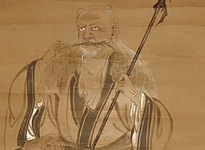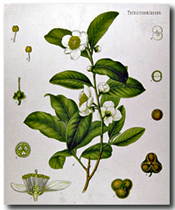|
Contents:
More:
Get the e-book edition of "Tea Time" >
|
Brief History of Tea
Perhaps it's not that simple, but the legend endures. From ancient China, tea drizzled down through the centuries and found its way to Japan, India, Portugal, France, Holland and Arab countries. Tea was first introduced to England in the late 1700's.
The Duchess of Bedford (Anna Maria Russell, 1783-1857) is credited with inventing the tradition of afternoon tea in England. It began in the 1840s, when dinner was not normally served until nine o'clock at night. It is said the Duchess would become hungry between lunch and dinner, so she started ordering a small repast of bread, butter, cakes and tarts, accompanied by a pot of tea. The meal would be brought in secret to her bedroom, but once she was exposed the habit caught on. It eventually became known as afternoon tea. While the Duchess cannot be credited wholly for the tradition, she certainly helped it along.
Tea gardens flourished, where bread and butter were served with the brew. In rural communities afternoon tea evolved into "high tea." Along with hot tea, meats, breads and cakes were served. High Tea is another acronym for "afternoon tea." It became such in rural communities and evolved into the main meal of the day. High tea was a cross between afternoon tea and the dinner, which was normally served in early evening. Tea also became an important social event, when people (especially women) would gather in their elegant drawing rooms and partake of their afternoon cuppa, talking discreetly about local events.
In England, Tea Shops were created in the mid-1800s when the manager of a bread company began to serve tea and other refreshments in her shop. It was a bit of a milestone in women's emancipation as "un-chaperoned" women were allowed to meet friends in a tea shop without besmirching their reputations. "Nursery Tea" was another form of afternoon tea, partaken by nannies of wealthier families, and was also a more substantial meal than afternoon tea. However, on another note, tea for the working class (or middle class) usually signified a break from work (or "tea break") much in the same way Americans have their "coffee breaks."
The "Crush, Tear, Curl" (CTC) method of harvest is used for low-quality leaves. A machine will compress withered leaves to extract their sap and then tear and curl the leaves into balls which resemble instant crystals. Afterward, the balls are fired. Tea produced is usually robust in flavor.
The "Orthodox" method of harvest is done mostly by hand. Processing usually includes withering, rolling, oxidation and firing. Leaves for black tea are typically spread out flat and then allowed to "wither" and become limp, which makes them easier to roll without breaking. The rolling process is commonly done by a machine to mix natural chemicals found in the leaves. Rolled tea leaves are then broken and allowed to oxidize. Longer oxidation periods result in pungent teas. Lastly, the leaves are fired and stored. Oolong teas are produced in similar fashion to black tea, but their oxidation period is less lengthy. Green teas are not oxidized and sometimes not even withered, but they are fired by baking, roasting or steaming.
• Next: Tea Types & Varieties >
|



 It
is said tea was discovered in 2737 BC when Chinese Emperor Shen Nung (Shennong)
sat beneath a wild tea tree while his servant boiled water. A leaf from the tree
wafted into the boiling water, so the Emperor decided to sample the brew. Thus
the wonder we know as tea was essentially born.
It
is said tea was discovered in 2737 BC when Chinese Emperor Shen Nung (Shennong)
sat beneath a wild tea tree while his servant boiled water. A leaf from the tree
wafted into the boiling water, so the Emperor decided to sample the brew. Thus
the wonder we know as tea was essentially born.
 For me, there is
nothing more soothing than a cup of tea. I drink a lot of coffee as well, but
reserve afternoons and evenings for a hot cup of tea. I prefer English
Breakfast or Chai teas with a simple dash of milk or non-dairy creamer. I
feel content after my cuppa, and somehow nourished and replenished. No matter
who, what or where you are, reserving part of each day for yourself is important
to mental well-being. Private time allows one to take stock of their day and to
muse over a variety of subjects. Nothing compliments it better than a good cup
of tea.
For me, there is
nothing more soothing than a cup of tea. I drink a lot of coffee as well, but
reserve afternoons and evenings for a hot cup of tea. I prefer English
Breakfast or Chai teas with a simple dash of milk or non-dairy creamer. I
feel content after my cuppa, and somehow nourished and replenished. No matter
who, what or where you are, reserving part of each day for yourself is important
to mental well-being. Private time allows one to take stock of their day and to
muse over a variety of subjects. Nothing compliments it better than a good cup
of tea.